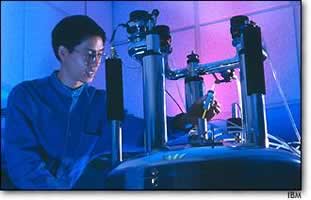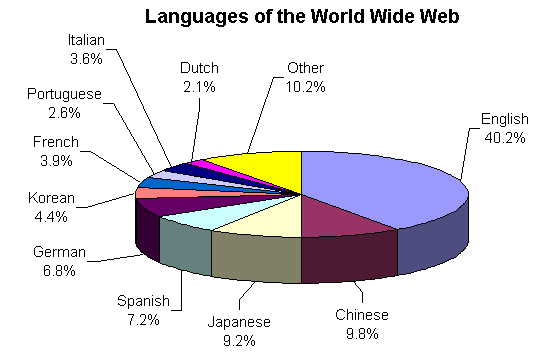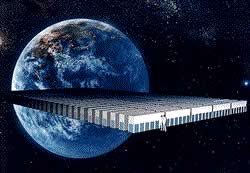You are here: mainpage > timeline
![]()
![]()
![]()
![]()
You are here: mainpage > timeline
|
The Industrial Era 2002 - onwards Since you honestly can not speak of historic events
for this period the editors had the idea to display the trends in
computing that has drawn attention in previous five or ten years.
As well as promising inventions and other developments that might
be of future value. |
pre history | antiquity | pre industrial era | industrial era
1947 - 1950
- 1952 - 1955 - 1958
- 1961 - 1963 - 1965
- 1969 - 1970 - 1972
- 1974 - 1976
1978 - 1980 -
1981 - 1982 - 1984 - 1986
- 1989 - 1991 - 1993
- 1994 - 1996 - 2000
- 2002
| Related Articles | |
| Supercomputing | |
| Related Resources | |

![]() Dr.
Isaac Chuang, research staff member at IBM's Almaden Research Center (San Jose,
Calif.), holds a quantum computer -- the glass tube contains special designed
molecules.
Dr.
Isaac Chuang, research staff member at IBM's Almaden Research Center (San Jose,
Calif.), holds a quantum computer -- the glass tube contains special designed
molecules.
Quantum computers promised to solve some of the most difficult mathematical problems exponentially faster than a conventional computer(2)

The multi billion question was: when will quantum computers be consumer ripe
in the next future. Some thought it will never be the case others predicted
the emergence within two decades.
![]() In 2002 English
was the Internet's main language, but it may not rule the digital waves for
long. By 2003 the number of Chinese speaking surfers is estimated to double.
(11)
In 2002 English
was the Internet's main language, but it may not rule the digital waves for
long. By 2003 the number of Chinese speaking surfers is estimated to double.
(11)

The number of Chinese Internet users has risen to 25.4 million from 8.9 in 1999. (19)
![]() May
2002, Hewlett-Packard merged with Compaq Computer forming the second largest
IT company on earth
May
2002, Hewlett-Packard merged with Compaq Computer forming the second largest
IT company on earth
![]() August 1 The
government of China appeared to be unsure about letting her citizens freely
roam the Internet and shut down those internet shops and cafes that had no official
license. In September this year the authorities also closed down the non Chinese
search engines. What was left accessible for the Chinese citizens was censored
by cybercops. China also asked foreign web sites to refrain from contents that
would be regarded as being subversive.
August 1 The
government of China appeared to be unsure about letting her citizens freely
roam the Internet and shut down those internet shops and cafes that had no official
license. In September this year the authorities also closed down the non Chinese
search engines. What was left accessible for the Chinese citizens was censored
by cybercops. China also asked foreign web sites to refrain from contents that
would be regarded as being subversive.
A few days later Google is on line again. But then user's screens remained blank
when requesting certain pages with political content.
This was the first time that a government tried to impose total control on the
contents of the Internet for its citizens. In the past there have been (partial)
attempts to do that by other governments(15) but all failed.
In the past the means, technology or infrastructure would not allow to have
total control and only the big holes could be plugged to bar free access to
the Internet. The government of China seemed to think differently. However this
action certainly gave other governments some new ideas.
In the latter months of this year the rules to use the Internet for Chinese
citizens were tightened and more stringently imposed

![]()
![]() All supercomputing
centers were flabbergasted by the public announcement of NEC's Earth
Simulator System (ESS). The performance overtook the fastest supercomputer
since two years: IBM's ASCI white by
a factor 5. This special purpose machine was entirely constructed on vector
processors and used for climatological research.
All supercomputing
centers were flabbergasted by the public announcement of NEC's Earth
Simulator System (ESS). The performance overtook the fastest supercomputer
since two years: IBM's ASCI white by
a factor 5. This special purpose machine was entirely constructed on vector
processors and used for climatological research.
The ultra high-speed parallel computing system, "Earth Simulator"
attained the best computing performance in the world according to the Linpack
benchmark(18) test. The result of this test of performance,
35.61 TFlops (trillion operations per second), was approved and the Earth Simulator
was registered as the world' s fastest supercomputer by Dr. Jack J. Dongarra
of the University of Tennessee, USA, who announced the world Linpack benchmark
test results.(17)

![]() Casio Computer
Co., Ltd. announced that the company has succeeded in developing small-scale,
high-performance fuel cells of a unique method that can be used in portable
devices. The reformer, so-called a unique micro-reactor formed on a silicon
wafer causes chemical reaction to reform methanol to hydrogen gas in the presence
of catalyst at a reforming rate of more than 98%. This is the first success
in the world in minimizing fuel cell of such high reforming rate.
Casio Computer
Co., Ltd. announced that the company has succeeded in developing small-scale,
high-performance fuel cells of a unique method that can be used in portable
devices. The reformer, so-called a unique micro-reactor formed on a silicon
wafer causes chemical reaction to reform methanol to hydrogen gas in the presence
of catalyst at a reforming rate of more than 98%. This is the first success
in the world in minimizing fuel cell of such high reforming rate.
![]() At Oviedo,
English Tim Berners-Lee, North Americans Vinton G. Cerf, Lawrence Roberts and
Robert Kahn, receive the Prince of Asturias Award for Technical and Scientific
Research 2002, for their groundbreaking contribution to the development of the
Internet and the World Wide Web.
At Oviedo,
English Tim Berners-Lee, North Americans Vinton G. Cerf, Lawrence Roberts and
Robert Kahn, receive the Prince of Asturias Award for Technical and Scientific
Research 2002, for their groundbreaking contribution to the development of the
Internet and the World Wide Web.
![]() According
to Israeli newspaper Ha'aretz, five youngsters have been charged with willful
damage to personal and business property by the writing and dissemination of
computer viruses, specifically W32/Goner. The indictment states that, amongst
the damage caused, the virus caused servers to crash at organizations including
NASA, a consulting company in New Jersey, Israeli company Radvision, and the
Interdisciplinary Center in Herzliya.(25)
According
to Israeli newspaper Ha'aretz, five youngsters have been charged with willful
damage to personal and business property by the writing and dissemination of
computer viruses, specifically W32/Goner. The indictment states that, amongst
the damage caused, the virus caused servers to crash at organizations including
NASA, a consulting company in New Jersey, Israeli company Radvision, and the
Interdisciplinary Center in Herzliya.(25)
![]() David Smith,
creator of the Melissa virus, has been sentenced to 20 months in a federal prison
and fined $5,000. The sentence comes nearly three years after Smith wrote and
released the program which caused millions of dollars of damage to computer
networks around the world.(25)
David Smith,
creator of the Melissa virus, has been sentenced to 20 months in a federal prison
and fined $5,000. The sentence comes nearly three years after Smith wrote and
released the program which caused millions of dollars of damage to computer
networks around the world.(25)
![]() On 23 August
2002 a US judge rejected a claim by "Maz Technologies that they had, in
1998, obtained a fairly generic patent covering the encrypted storage of documents.(25)
On 23 August
2002 a US judge rejected a claim by "Maz Technologies that they had, in
1998, obtained a fairly generic patent covering the encrypted storage of documents.(25)
![]() March
18, In Kodiakanal, India. Adam Osborne, the creator of the first portable computer,
dies at 64.
March
18, In Kodiakanal, India. Adam Osborne, the creator of the first portable computer,
dies at 64.
![]() April,
18; Edgar (Ted) Codd, the mathematician and former IBM Fellow best known for
creating the "relational" database model dies.
April,
18; Edgar (Ted) Codd, the mathematician and former IBM Fellow best known for
creating the "relational" database model dies.
![]() Casio
Computer Co. unveiled a fuel-cell unit for a laptop PC that carries what the
company calls a "microreformer." The company said it had succeeded
in drastically reducing and miniaturizing components so that the reformer could
be the size of a stamp. Casio's fuel-cell-powered laptop, which the company
said would be introduced by early 2005, can power a laptop computer for as long
as 20 hours, compared with four to five hours for a typical lithium-ion battery.
Casio
Computer Co. unveiled a fuel-cell unit for a laptop PC that carries what the
company calls a "microreformer." The company said it had succeeded
in drastically reducing and miniaturizing components so that the reformer could
be the size of a stamp. Casio's fuel-cell-powered laptop, which the company
said would be introduced by early 2005, can power a laptop computer for as long
as 20 hours, compared with four to five hours for a typical lithium-ion battery.
![]() The
Japanese News Agency Kyodo announces that the European Central Bank is looking
at the possibility of embedding the world's smallest integrated circuit, developed
by Hitachi, into notes to prevent counterfeiting of euros.
The
Japanese News Agency Kyodo announces that the European Central Bank is looking
at the possibility of embedding the world's smallest integrated circuit, developed
by Hitachi, into notes to prevent counterfeiting of euros.
![]() The
World Wide Web Consortium announced its formal policy for ensuring that key
Web technologies, even if patented, are made available on a royalty-free basis.
In a statement, the consortium said that the W3C Patent Policy is designed to
reduce the threat that key components of Web infrastructure may be covered by
patents which block further development.
The
World Wide Web Consortium announced its formal policy for ensuring that key
Web technologies, even if patented, are made available on a royalty-free basis.
In a statement, the consortium said that the W3C Patent Policy is designed to
reduce the threat that key components of Web infrastructure may be covered by
patents which block further development.
![]() The
New York Times publishes a notice about the National Center for Supercomputing
Applications, where Mike Showerman and Craig Steffen have built a supercomputer
with components purchased at retail prices, with a cost a little more than $50,000.
The center's researchers believe the system may be capable of a half trillion
operations a second, well within the definition of supercomputer, and is built
with 70 Sony's Play Station 2 game machines. The chip is not the PlayStation
2's MIPS microprocessor, but rather a graphics coprocessor known as the Emotion
Engine. That custom designed silicon chip is capable of producing up to 6.5
billion mathematical operations a second. The system uses Linux and a high speed
Hewlett-Packard Switch to connect them all.
The
New York Times publishes a notice about the National Center for Supercomputing
Applications, where Mike Showerman and Craig Steffen have built a supercomputer
with components purchased at retail prices, with a cost a little more than $50,000.
The center's researchers believe the system may be capable of a half trillion
operations a second, well within the definition of supercomputer, and is built
with 70 Sony's Play Station 2 game machines. The chip is not the PlayStation
2's MIPS microprocessor, but rather a graphics coprocessor known as the Emotion
Engine. That custom designed silicon chip is capable of producing up to 6.5
billion mathematical operations a second. The system uses Linux and a high speed
Hewlett-Packard Switch to connect them all.
 (24)
(24)
![]() Spam
is e-mail that is not wanted, is one of the shortest definitions. In this year
Spam has become a serious nuisance
and takes up more and more of the internet resources. So much so that universities
are creating a new, and more important, faster internet to get rid of this:
Internet 2. This network will not be open to the public.
Spam
is e-mail that is not wanted, is one of the shortest definitions. In this year
Spam has become a serious nuisance
and takes up more and more of the internet resources. So much so that universities
are creating a new, and more important, faster internet to get rid of this:
Internet 2. This network will not be open to the public.
Up to 3 out of 10 emails of an average e-mail user is spam. For heavy users
who have at least one reference to their e-mail address on one or more web sites
receive 60-90% Spam in their mail box. Leaving one's true e-mail address on
a newsgroup or forum assures you to even more Spam. Some times to almost 95-99%
Spam, thus 1 out of 100 e-mails in your in-box is unsolicited e-mail.
The industry fights back in setting up anti Spam sites which are using Spam
filters, setting up black lists of spam senders, servers, or proxies. And so
on. The Spam filtering techniques are getting better but the Spammers too. A
war is waging on the e-mail front!
Read on the history of
spam ![]()
![]() Jan - The
Google search engine now indexes 3.3 bln (in fact, 3,307,998,701) WWW pages.
Google search engine continues to be the largest index on the web. (22)
Jan - The
Google search engine now indexes 3.3 bln (in fact, 3,307,998,701) WWW pages.
Google search engine continues to be the largest index on the web. (22)
![]() 'Junior’
or‘the second’ was apparently too common for the son of American
programmer Jon Blake Cusack. His son is now named Jon Blake Cusack 2.0 is literally
version 2."Jon Blake Cusack 2.0 has much in common with version 1.0, but
got extra features from his mother Jamie", a proud father wrote in an e-mail
to friends and family.(20)
'Junior’
or‘the second’ was apparently too common for the son of American
programmer Jon Blake Cusack. His son is now named Jon Blake Cusack 2.0 is literally
version 2."Jon Blake Cusack 2.0 has much in common with version 1.0, but
got extra features from his mother Jamie", a proud father wrote in an e-mail
to friends and family.(20)
![]() ISEC Security
Research found a critical vulnerability in code that is used to manage virtual
memory on Linux systems. The vulnerability affects versions of the Linux kernel
up to and including version 2.6 and would give low-level Linux users total control
over a Linux system.
ISEC Security
Research found a critical vulnerability in code that is used to manage virtual
memory on Linux systems. The vulnerability affects versions of the Linux kernel
up to and including version 2.6 and would give low-level Linux users total control
over a Linux system.
![]() America
Online, Inc., announces that it would make spy ware protection available as
a standard feature to both narrowband and broadband members as it introduces
additional enhancements to AOL(R) 9.0 .
America
Online, Inc., announces that it would make spy ware protection available as
a standard feature to both narrowband and broadband members as it introduces
additional enhancements to AOL(R) 9.0 .
![]() 250,000
computers launch Mydoom (1 Feb. 2004)
250,000
computers launch Mydoom (1 Feb. 2004)
New York: The Mydoom computer virus caused 250,000 computers worldwide to bombard the web site of SCO Group Inc. in the largest of such electronic attacks. SCO Group, which is in a legal fight for control of the Unix operating system, shut down the site after the attack began, Blake Stowell, a spokesman for the Lyndon, Utah-based company, said. Mydoom, which first appeared a little over a week ago, spreads an e-mail attachment that makes computers send waves of requests to specified web sites. A second strain, dubbed Mydoom.B, is programmed to attack the site of Microsoft Corp., whose products run on about 95% of personal computers, tomorrow, (NZ time).
"We've never seen an attack with this many computers participating," said Mikko Hypponen, director of virus research with Helsinki-based F-Secure Oyj. "This kind of army of infected computers could accomplish far greater attacks than just bringing down a web site."
SCO took down its web site to prevent the attack from hurting its Internet service provider and slowing the Internet, Mr. Stowell said, rather than setting up an alternate web site. SCO Group is offering $US250,000 for information leading to the capture and conviction of the virus' author. Redmond, Washington-based Microsoft is also offering a $US250,000 reward.Mydoom is spreading faster than last year's SoBig virus, which set up programs on infected computers in August to send mass mailings of unsolicited e-mail. A similar virus, the Blaster worm, targeted Microsoft's software-download site in August. That attack was averted when Microsoft took down the site. (21)
![]() Something unique
happened in March this year: creators of viruses wage a tug of war against each
other! A week long of insults embedded inside the virus code as comments, toward
one of the others in ever new variants of the viruses: Netsky, Mydoom and Bagle
These three worms plagued the Internet starting the end of February. The newest
variant Netsky.K announces to stop this war of words and to stop with spreading
new versions. Many e-mail recipients will take a breath of relieve.
Something unique
happened in March this year: creators of viruses wage a tug of war against each
other! A week long of insults embedded inside the virus code as comments, toward
one of the others in ever new variants of the viruses: Netsky, Mydoom and Bagle
These three worms plagued the Internet starting the end of February. The newest
variant Netsky.K announces to stop this war of words and to stop with spreading
new versions. Many e-mail recipients will take a breath of relieve.
![]() Spam
takes up more than 33% of e-mail traffic and this number is growing fast. Also
rising is the general concern that spam will kill e-mail as it is used in this
year: free to use without practical limitations.
Spam
takes up more than 33% of e-mail traffic and this number is growing fast. Also
rising is the general concern that spam will kill e-mail as it is used in this
year: free to use without practical limitations.
This realization expresses it selves on March 12, 2004. A ISP provider in the
Netherlands XS4ALL has won a Supreme Court's case against a spammer to block
all spam from its servers. Judges ruled that freedom of expression as carried
by the spammer AbFab, under weighed the economic damage caused by spam in using
XS4ALL's computer capacity, bandwidth and customers data. Now spam can be blocked
on all ISP's, at least in the Netherlands.(23) A few days
after the ruling XS4All is warning spammers via a newspaper ad not to send any
spam.
In Singapore government is also willing to fight spam with more stringent regulations
and bylaws. If this is a trend only a few pockets on the world will be free
for spammers to operate from. These can be easily controlled by blocking anything
that comes from these locations. Possibly governments are going to use what
the Chinese and other governments have done by means of content filters on the
Internet.
So far legislation is feeble, favoring businesses above the users receiving the annoying e-mail. This is not helping at all but legislators obviously do not want to make a strong case against spammers in saying to protect free and open markets. In most countries Spam lobbies appear to be stronger than the general public's wish to get rid of this unwanted e-mail.
Read on the history of spam ![]()
![]()
| Last Updated on July 21, 2004 | For suggestions please mail the editors |
Footnotes & References